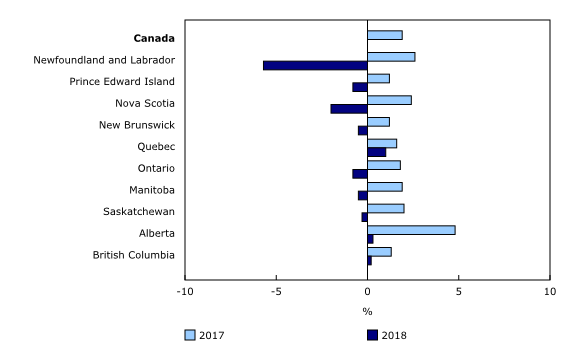Estimates of multifactor productivity growth in the provinces, 2018
Archived Content
Information identified as archived is provided for reference, research or recordkeeping purposes. It is not subject to the Government of Canada Web Standards and has not been altered or updated since it was archived. Please "contact us" to request a format other than those available.
Released: 2020-05-19
Multifactor productivity in the business sector declined in most provinces in 2018, following an increase in all provinces in 2017. Multifactor productivity measures the extent to which inputs are efficiently used in the production process. Growth in this area is often associated with technological change, organizational change and economies of scale. The COVID-19 pandemic is expected to affect growth in inputs (capital and labour) and growth in multifactor productivity. Its full impact will be reflected in multifactor productivity growth estimates starting in reference year 2020.
The declines in multifactor productivity in the four Atlantic provinces in 2018 were among the largest in Canada: Newfoundland and Labrador (-5.7%), Nova Scotia (-2.0%), Prince Edward Island (-0.8%), and New Brunswick (-0.5%). Multifactor productivity increased in three provinces in 2018: Quebec (+1.0%), Alberta (+0.3%) and British Columbia (+0.2%). Overall, multifactor productivity was unchanged in the business sector in 2018, following a 1.9% gain in 2017.
The decline in multifactor productivity in 2018 followed an improvement in multifactor productivity growth in Canadian provinces since the global recession and financial crisis in 2008 and 2009. From 2000-2010 to 2010-2017, multifactor productivity growth increased in every province except Newfoundland and Labrador and Manitoba.
Note to readers
This release is based on the database of provincial multifactor productivity and related variables for the business sector industries from 1997 to 2018. Data include multifactor productivity, value-added, capital input and labour input in the aggregate business sector and major sub-sectors.
This database is constructed using a methodology that is similar to the one used to construct multifactor productivity estimates at the national level, released in The Daily on March 9, 2020.
Data in this release reflect the estimate of gross domestic product by industry in the provinces and territories for 2018, published in The Daily on May 1, 2019; estimates of stock and consumption of fixed assets for 2018, published in The Daily on November 19, 2019; and estimates of hours worked and labour productivity in the provinces and territories for 2018, published in The Daily on February 12, 2020.
Multifactor productivity measures at Statistics Canada are derived from a growth accounting framework that allows analysts to isolate the effects of increases in input intensity and skills upgrading on the growth in labour productivity. The residual portion of labour productivity growth that is not attributable to increases in input intensity and skills upgrading, is called "growth in multifactor productivity." It measures the efficiency with which the inputs are used in production. Growth in this area is often associated with technological change, organizational change or economies of scale.
Products
A description of the method used to derive productivity measures can be found in the "User Guide for Statistics Canada's Annual Multifactor Productivity Program," as part of The Canadian Productivity Review series (15-206-X).
The documentation about revisions to multifactor productivity growth estimates can be found in "Revisions to the Multifactor Productivity Accounts" as part of The Canadian Productivity Review series (15-206-X).
Contact information
For more information, or to enquire about the concepts, methods or data quality of this release, contact us (toll-free 1-800-263-1136; 514-283-8300; STATCAN.infostats-infostats.STATCAN@canada.ca) or Media Relations (613-951-4636; STATCAN.mediahotline-ligneinfomedias.STATCAN@canada.ca).
- Date modified:


